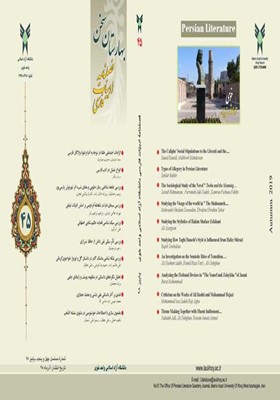-
-
List of Articles
-
Open Access Article
1 - The Caliphs' Social Stipulations to the Literati and the Infiltration of Farsi Words ( The first period of the Abbasid dynasty )
Saeed Hamidi Mahboob Mahdavian -
Open Access Article
2 - Types of Allegory in Persian Literature
Sardar Bafekr -
Open Access Article
3 - The Sociological Study of the Novel " Tooba and the Meaning of the Night" from Shahr Noosh Parsi Pour
Zeinab Rahmanian leila adlparvar Kamran Pashaee Fakhri -
Open Access Article
4 - Studying the Visage of the world in " The Shahnameh of Ferdowsi " Based on the Propagandistic Literature
Mehraneh Gholami Davoodi Ebrahim ebrahimtabar -
Open Access Article
5 - Studying the Stylistics of Hakim Shafaee Esfahani
Ali Azargoon -
Open Access Article
6 - Studying How Taghi Danesh's Style is Influenced from Hafez Shirazi
Rajab Tohidiyan -
Open Access Article
7 - An Investigation on the Semiotic Rites of Transition in " The Gol and Nowrooz " from Khajooyeh Kermani
Ali Hashem zadeh Hamid Reza farzi Ali Dehqan -
Open Access Article
8 - Analyzing the Fictional Devices in " The Yousef and Zolaykha " of Jaami
Barat Mohammadi -
Open Access Article
9 - Criticism on the Works of Ali Dashti and Mohammad Hejazi
Mohammad Issa Zadeh Haji Agha -
Open Access Article
10 - Theme Making Together with Fluent Inditement ( calligraphy ) Expressions in the Mathnavi of the Selselatozzahab ( The Haft Owrang of Jaami )
Nahideh Adli Ali Dehqan Rostam Amani Astmal
-
The rights to this website are owned by the Raimag Press Management System.
Copyright © 2021-2025







